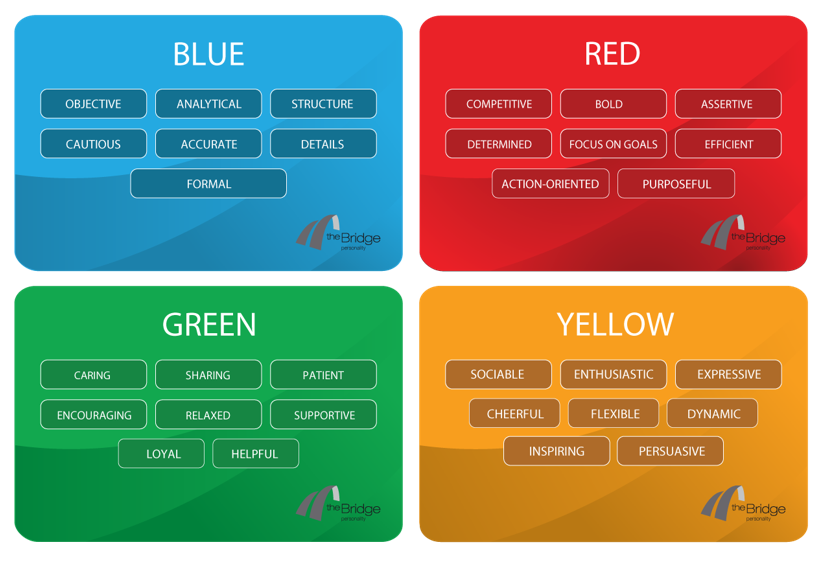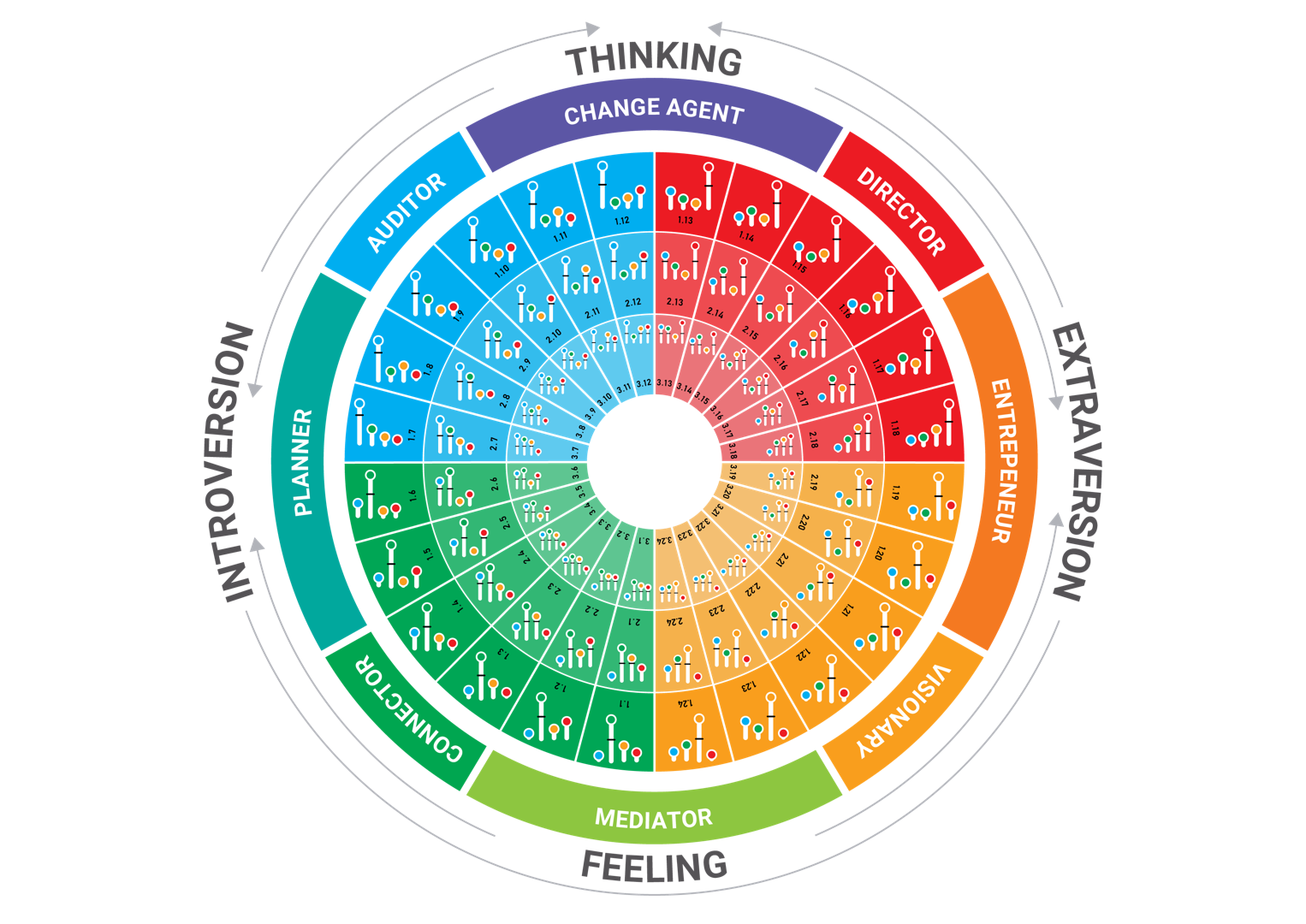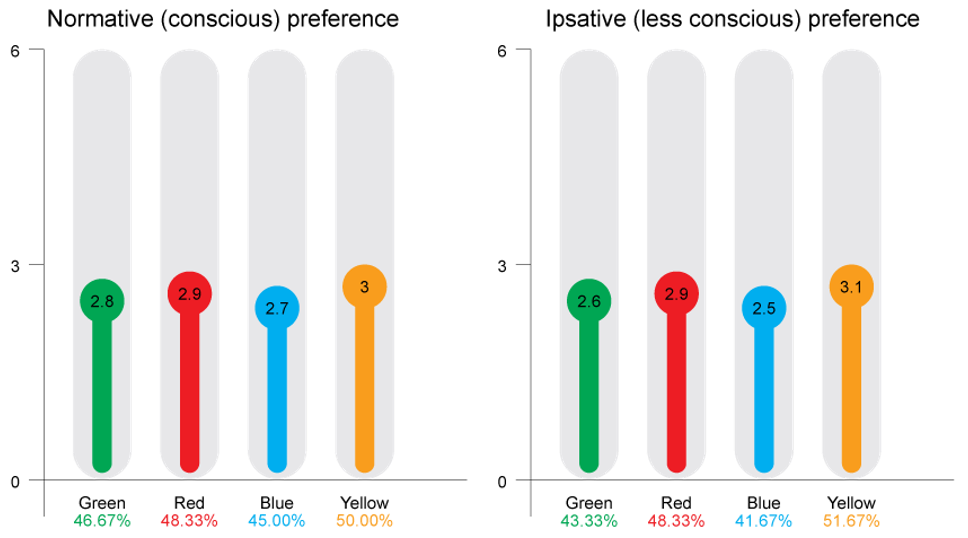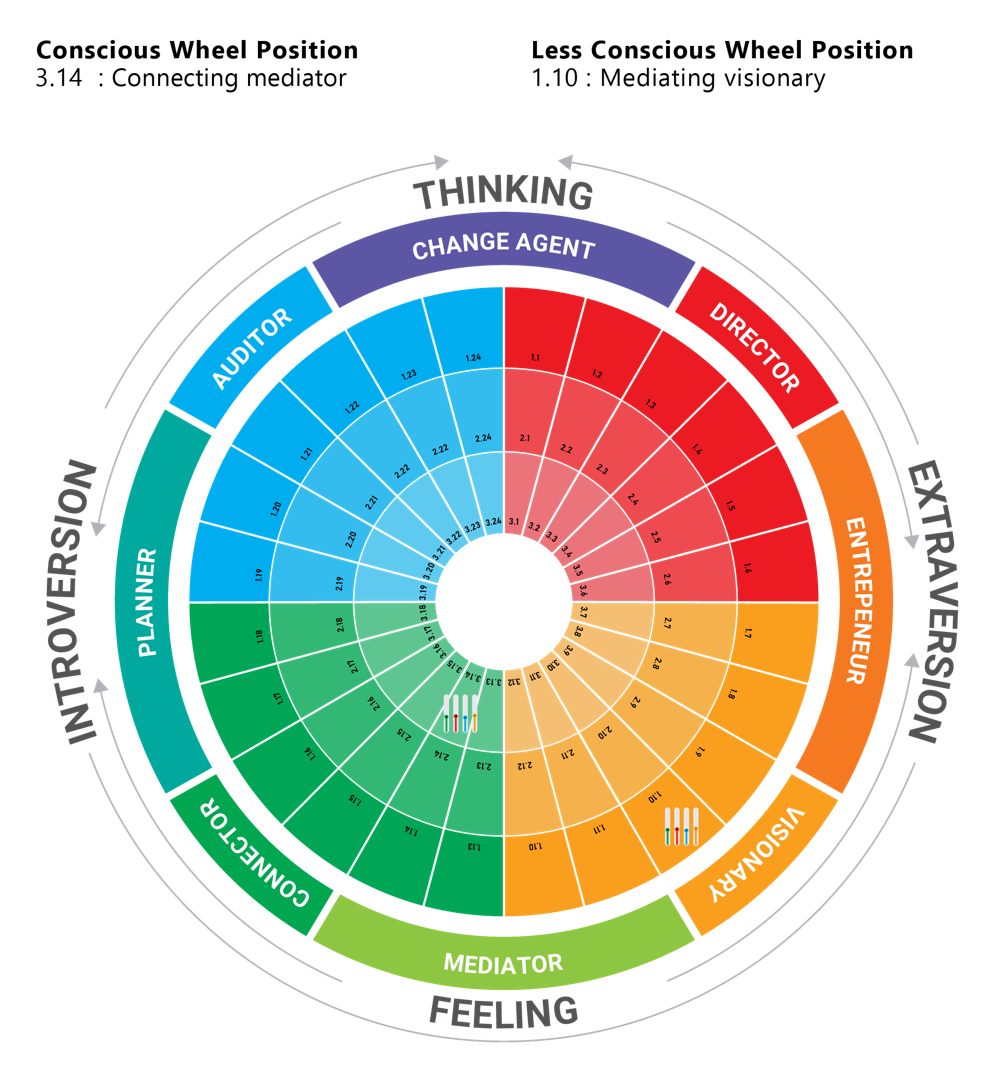The 4-color wheel
The 4-color personality wheel is a visual framework that maps individual traits across 72 unique positions, derived from four core colors: Red, Yellow, Green, and Blue. It includes eight personality types—such as the Director, Visionary, and Connector. This model is similar to the Insights Discovery Wheel.
What is a 4-color personality wheel?
A 4-color personality wheel is a simple model that visualizes personality types using four colors: red, yellow, green, and blue. Each color represents a specific communication style and set of behavioral traits.
The 4-color personality wheel helps people understand their own strengths and challenges, while also showing how they interact with others. Organizations use this model in recruitment, team development, leadership training, and coaching because it is easy to understand and apply in practice.

How the 4-color personality wheel works
The 4-color personality test starts with a detailed questionnaire designed to identify an individual’s primary color energy and corresponding personality type. Based on Carl Jung’s theory of psychological types, the test evaluates how people prefer to think, act, and interact with others. This creates a personalized profile that reveals intrinsic motivations and helps align these traits with others for better collaboration.
The framework identifies four main color energies:
The 4-color wheel explained: Red, Yellow, Green, Blue
Understanding these energies in yourself and others improves interpersonal connections and communication. It helps teams recognize complementary strengths and use them effectively for collective success. For example, blending Yellow’s creativity with Blue’s precision can create innovative yet practical solutions.
The test also emphasizes tailoring communication to match the dominant color energy of others. Adapting your approach makes messages more likely to resonate, reduces conflicts, and promotes inclusivity.
The 4-color personality test is not just a one-time activity; it’s an ongoing journey for growth. Teams and individuals should check their profiles regularly to reflect on their progress and any changes. This ongoing effort leads to lasting benefits like better teamwork, improved leadership, and personal satisfaction, while also making personality understanding a key part of the organization’s culture.

The 4 colors and 8 personality types
The 4-color personality test identifies four core color energies—Red, Yellow, Blue, and Green—each representing unique traits and behaviors. These colors combine to form eight personality types, each with its own strengths and characteristics:
The 4 color wheel: conscious and unconscious personas
The scores in the 4-Color Personality Report are calculated using both normative and ipsative methods. Normative scoring measures how strongly a candidate agrees or disagrees on a scale from 1 to 9 (1 = very strong disagreement, 9 = very strong agreement). Ipsative scoring uses a "forced choice" format, where candidates rank items in order of relevance (1 = least applicable, 6 = most applicable). Combining these two methods provides a more accurate and reliable understanding of self-perception and personality, as supported by research in testing theory.
The 4-Color Personality Test also considers both your conscious persona—how you intentionally act—and your unconscious persona—how you instinctively react. Understanding these two aspects helps you reflect on your behaviors and identify areas for improvement.
The conscious persona (Conscious score) is represented by the normative test scores, the unconscious persona (Less Conscious score) is represented by the ipsative test scores.

How to read the 4-color personality test wheel
The 4-color personality test wheel is a visual tool that maps an individual’s personality preferences and energies. Divided into four color quadrants—Red, Yellow, Blue, and Green—the wheel highlights distinct behavioral and communication styles.
Understanding the wheel begins with recognizing that no one fits solely into one quadrant; instead, each person exhibits a unique blend of colors, with one or two colors being more dominant. By linking Thinking and Feeling preferences with Extraversion and Introversion, the wheel identifies eight personality types.
The 4-color wheel's structure
The 4-color wheel has three rings, creating 72 subtypes based on color preferences:
- Inner ring: Dominance of three colors above the centerline.
- Middle ring: Dominance of two colors above the centerline.
- Outer ring: Dominance of one color above the centerline.
Some people may have preferences that span different areas when their conscious (normative) preferences do not align with their less conscious (ipsative) preferences. While no one perfectly represents all four colors, individuals can develop behaviors associated with less dominant colors through effort and intention.

Interpreting the the 4-color wheel
The position and spread of colors in the wheel reveal how individuals approach work, communication, and relationships:
- A wider spread suggests versatility and adaptability.
- A concentrated distribution indicates strong specialization and depth in specific areas.
It’s important to consider how these energies shift under stress, as behaviors can change significantly in challenging situations.
Personal and team development with the four color energies
Understanding the main and supporting colors on the color wheel is important for personal growth. It helps people recognize their strengths, improve on their weaknesses, and develop better communication skills. This awareness also improves relationships and enhances interpersonal skills by valuing different viewpoints.
For teams, the 4-color personality test is a practical tool to analyze group dynamics and improve collaboration. Leaders can use the Team Workshop Do-It-Yourself Package to introduce team members to their personality traits and learn how different strengths complement each other. The 4-Color Team Report provides a clear, detailed overview of the team’s collective personality dynamics, making it easier to align tasks with individual strengths, build mutual respect, and reduce conflicts. Together, these tools offer a visual and actionable representation of the team’s energy, helping leaders promote balance, tackle challenges effectively, and celebrate successes as a cohesive unit.
Sample: 4-color report
The 4-color report offers ratings on 34 Big Five competencies, outlines the candidate's 4-color preferences, and assesses performance on 8 general competencies. This provides a comprehensive insight into your candidate’s personality.
Team workshop: Do-It-Yourself kit
The Do-It-Yourself team workshop provides all the tools you need to run a session without a facilitator. The package includes 4-color personality tests, a detailed team report, and presentation slides. With personalized insights for each member and a full team overview, you can start immediately and boost collaboration.
-
What is the 4 Color Personality Wheel?
-
The 4 Color Personality Wheel is a visual model that shows personality preferences using four colors: red, yellow, green, and blue.
-
How does the 4 Color Personality Wheel work?
-
The 4 Color Personality Wheel shows how someone prefers to think, act, and communicate by placing them on a wheel with 72 positions. These are based on the balance between the four color styles.
-
What do the colors mean in the 4 Color Personality Wheel?
-
Each color stands for a different personality trait:
Red = direct and determined,
Yellow = energetic and social,
Green = caring and supportive,
Blue = precise and thoughtful.
-
Is the 4 Color Personality Wheel based on science?
-
Yes. The model is based on the psychological theories of Carl Jung and is widely used by companies and coaches around the world.
-
How many personality types are in the 4 Color Personality Wheel?
-
There are 8 main personality types, each showing a unique mix of the four colors. These types help people understand their natural style and how they relate to others.
-
Can teams use the 4 Color Personality Wheel?
-
Absolutely. Teams use the Wheel to improve communication, understand each other's strengths, and build better collaboration.
-
Is the 4 Color Personality Wheel the same as a personality test?
-
Yes, it's a personality test—but with a clear and visual twist. Instead of only scores, you get a colorful wheel that makes your personality easy to understand and apply.
-
Who should use the 4 Color Personality Wheel?
-
It’s great for managers, HR professionals, coaches, and teams who want to work better together and communicate more effectively.
-
How is the 4 Color Personality Wheel different from other models?
-
This model is simple, visual, and easy to remember. It focuses on everyday behavior using four recognizable color styles, making it practical for use in real situations.